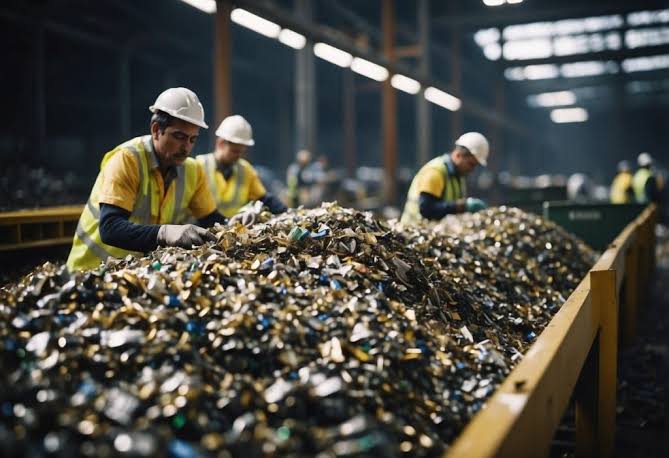CNC vs Laser Cutter Comparison
Machines that cut using a CNC or a laser are very adaptable. Their cutting and engraving capabilities make them indispensable in customized manufacturing. To shape materials with precision, both are necessary.
Their application and approach, however, are very different. This article compares and contrasts CNC vs laser cutter systems, which include mills and routers. It gives you a full comparison so you can pick the right tool for the job.
Understanding these differences can help you get the finest outcomes in your custom metalwork, whether working on structural components or complex designs.
What is CNC Machining and How does it work?
The abbreviation CNC refers to a computer numerical control system commonly employed in the industrial sector. Machines, including lathes, grinders, routers and switches, and mills, are controlled by computers in this process. A computer regulates the tools, from speed and feed rate to synchronization.
CNC employs special machining to make pieces of different dimensions and shapes. The procedure begins when a designer draws a customer’s specs. Designers use CorelDRAW or AutoCAD to sketch on computers instead of drawing manually on a drawing board. CNC metal machining uses high-speed cutting tools for intricate designs. It ensures great accuracy and reproducibility.
A CNC programmer uses CAM software to turn the electronic drawing into a workpiece. The programmer may construct a CNC machine G-code using CAM software. The computer transmits to a CNC machine to interpret the design. CNC milling machines and routers could cut in all three axes simultaneously. They come in various materials, sizes, and cuttings.
Advantages of CNC Machining:
CNC machining is vital for industries that value efficiency and accuracy. CNC machining is ideal for long-lasting goods and quality control. Here’s a closer look at its key advantages: Let’s elaborate on its main advantages:
Material Compatibility Versatility
CNC machines can process metals, polymers, composites, wood, acrylic, and MDF. CNC routers work better with acrylic and wood than CNC milling machines, which have more power and torque.
High Precision
Accurate, waste-free products are made using computer numerically controlled (CNC) machining. It’s used in healthcare, aerospace, and automotive sectors. These machines use advanced algorithms to find the best machining route. This saves material and ensures a flawless output.
Large-Scale Production Friendly
CNC machines are efficient and reliable for large-scale manufacturing. These machines can mass-produce components quickly. Their high speeds and feeds ensure quality. Better Security, Fewer Errors. Automated numerical control (NC) equipment follows computer instructions.
Reduced Errors
It reduces human error and makes defect-free goods. These gadgets’ automated functions keep operators safe, reducing workplace accidents. CNC machining optimizes power and material use. It cuts costs.
Due to these properties, it is an eco-friendly solution for businesses. They want to boost output while cutting costs. CNC machining is popular with producers who value precision, productivity, and security. They leverage its benefits.
What is Laser Cutting and How Does It Work?
Laser cutting involves using a high-powered laser beam to cut or engrave materials. This method works well for tasks needing intricate patterns. These include custom metal laser cutting and engraving.
Laser cutting is the same as CNC machining. The only difference is that it eliminates touch during the cutting process. This technique uses a strong laser beam. It cuts or engraves materials into precise forms, patterns, or designs.
The procedure starts with a laser cutter guiding the light beam via a set of mirrors and a lens that focuses it. A very narrow region on the substance is illuminated by the beam. A clean cutting edge can be achieved by vaporizing or melting the material with the heat generated by the concentrated laser beam.
A computerized design, made in a CAD program or similar, is the starting point for laser cutting. The laser cutter translates the computer instructions into the exact motions of the laser beam. The laser cutting can be done by adjusting the laser beam’s strength, speed, and focus. Lasers are often used to cut materials such as rubber, metals, wood, paper, leather, fabric, etc.
Laser Cutting Types:
CO2 Laser: The carbon dioxide (CO2) is the one that is most often used. Because of its sensitivity and its capacity to cut a wide variety of materials, such as polymers, wood, paper, glass, and clothing, it is highly desirable.
Fiber lasers: Fiber lasers are known for their ability to cut reflective materials, like aluminium and copper. They do this without damaging the equipment from back reflections. The extreme intensity and pinpoint accuracy of crystal lasers make them ideal for cutting and engraving.
Advantages of Laser Cutting:
Laser cutting is used in many industries for accuracy and intricacy. Laser cutting offers several advantages. Its versatility and efficiency make it a modern technology for many applications. Its benefits are outlined below:
Transparent Laser cutting Sheet Metal Works Well
Laser cutting sheet metal is an excellent technique for processing thin materials. No-contact cutting minimizes distortion. It protects the strength of even the most delicate materials. This makes it ideal for industries that prioritize precision and refuse to utilize inferior materials.
Unmatched Form and Function Detail
Laser beams cut intricate shapes with great accuracy. So, they are perfect for both aesthetic and functional uses. Laser cutters are better for engraving elaborate patterns on fabric or metal or producing clean cuts.
Flexibility across Materials
Lasers can cut wood, fabric, leather, plastic, aluminum, and steel. Due to its versatility, businesses may use one machine to make industrial components and artistic designs.
Suitable for Any Production Run
For any run, laser cutting ensures quality and precision in both prototypes and mass production. Due to its mechanization and strict regulations, every cut is flawless, and waste is eliminated.
Superior Finishes and Smoother Surfaces
Laser cutters provide smoother, cleaner edges than other methods. By melting and vaporizing the material instead of removing it, they leave no burrs or rough edges. This reduces post-processing and improves the product’s appearance.
Minimizing waste and increasing Efficiency
Laser cutters reduce waste and increase efficiency. They are very accurate. Laser cutters are fast and cheap. They may help businesses cut costs and lessen their environmental impact. Laser cutting is a quick, high-quality solution. It is accurate and adaptable. It has many benefits.
CNC vs Laser Cutter: Key Differences
When it comes to production and layout, both CNC and laser cutters are widespread. However, their functioning, capabilities, and applications differ substantially. This table compares CNC vs laser cutter. It helps readers choose the right tool.
| Feature | CNC Machine | Laser Cutter |
| Working Principle | Cuts material with the use of physical equipment such as drills, routers, or mills. | Uses a powerful laser beam to melt or evaporate the material to cut or etch it. |
| Precision | Achieves accuracy up to ±0.004″ (±0.1mm) but is restricted by the size of the cutting tool. | Offers better precision, often ±0.0004″ (±0.01mm), perfect for detailed and delicate patterns. |
| Material Compatibility | Works with many materials, from thin to thicker, such as metals, polymers, and composites. | Thinner materials, such as acrylic, leather, and some metals, are ideal for this laser. |
| Cutting Speed | Lower speed than lasers; dense materials may need more than one pass. | Quicker for delicate fabrics and complex patterns; requires fewer passes to finish cutting. |
| Maintenance | Regular cleaning is necessary to prevent dirt, chips, and damage to moving components. | Lower maintenance demands, including regular washing of optical elements like mirrors and lenses. |
| Learning Curve | Higher learning curve; needs experience in CAD, CAM, and G-code programming. | The software and pre-set parameters make it easier to operate. |
| Material Waste | It creates dust and debris; dust collection is needed. | Produces little tangible waste; nonetheless, enough ventilation is required due to smoke and fumes. |
| Cost of Operation | Higher as a result of energy usage, lubrication, and tool replacements. | Reduced operating expenses, but costly laser module replacements regularly. |
| Footprint | It needs room for dust collectors and lubrication reservoirs. | Perfect for workshops with limited space due to its compact design and modest footprint. |
| Applications | An ideal material for structural components, molds, 3D carving, and mass manufacturing. | Perfect for delicate work, 2D cutting thin materials, and engraving elaborate designs. |
| Noise | High Noise | Low Noise |
| Safety | Handle with care since there are moving components; use protective clothing. | Though most enclosed designs are safe, many open lasers require eye protection. |
You can choose between CNC machining and laser cutting according to your project’s needs. If you need structural patterns with tight tolerances, CNC metal machining is your best bet. For projects with complex patterns, a laser cutting service can deliver great results.
Conclusion
When deciding between CNC vs laser cutter for creating unique metal components. Both methods have their benefits. Laser cutting excels at creating complex patterns and efficient laser engraving. CNC machining is known for accurately handling many materials and making structural components. You can get your CNC services from CNC machining parts manufacturer in china.The best option will depend on your project’s needs. Choose a laser cutting service for its precision, engraving ability, and creativity. Choose CNC machining metal for its precision and durability. If you want your projects done quickly, efficiently, and with impeccable quality, you should choose a reliable supplier that offers CNC services and laser engraving.





